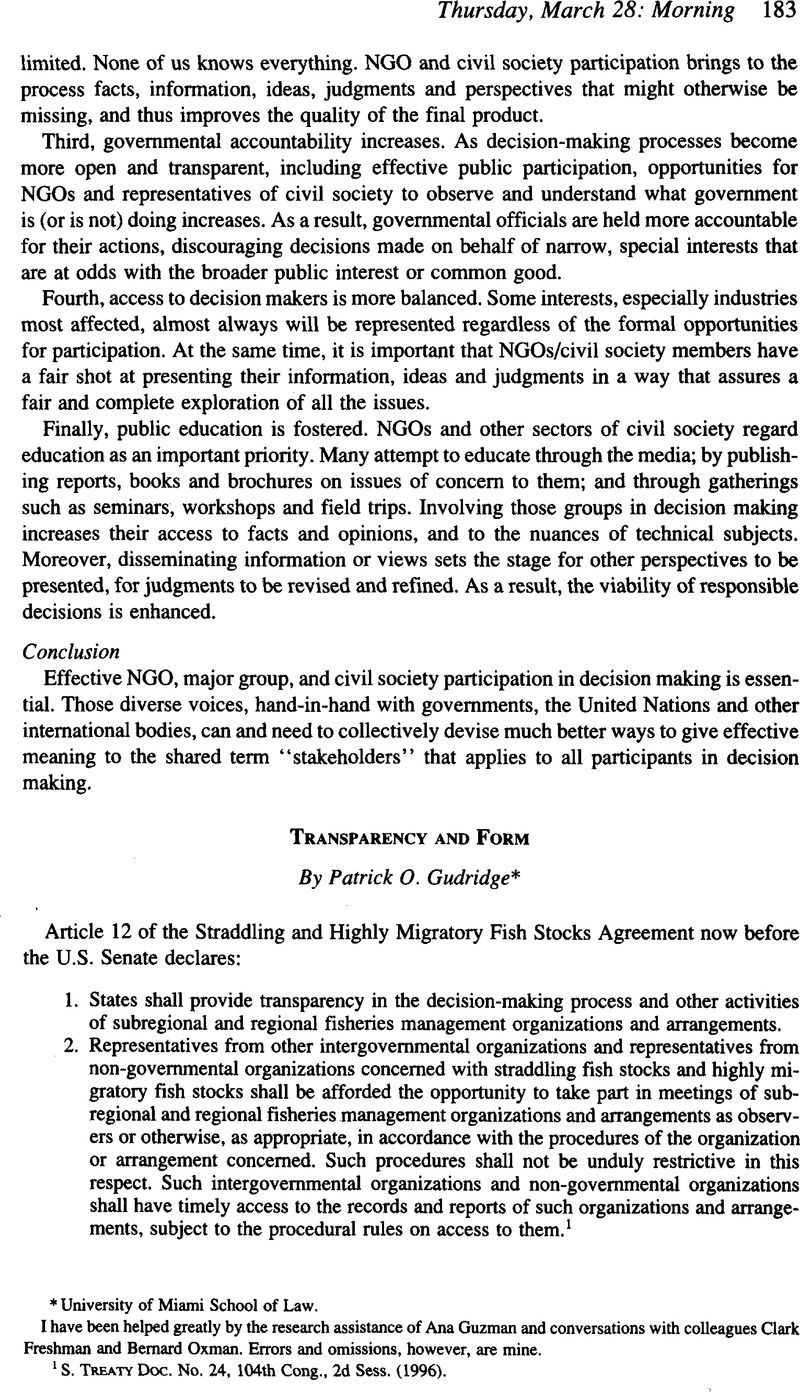No CrossRef data available.
Article contents
Transparency and Form
Published online by Cambridge University Press: 17 February 2017
Abstract

- Type
- Transparency, Accountability and Private Actors
- Information
- Copyright
- Copyright © American Society of International Law 2015
References
I have been helped greatly by the research assistance of Ana Guzman and conversations with colleagues Clark Freshman and Bernard Oxman. Errors and omissions, however, are mine.
1 S. Treaty Doc. No. 24, 104th Cong., 2d Sess. (1996).
2 “Because the effect of involving NGOs in international negotiations has not been studied in depth, it is difficult to assess the precise costs and benefits of doing so.“ Note, Discretion and Legitimacy in International Regulation, 107 Harv. L. Rev. 1099, 1111 (1994). For evident skepticism, see, e.g., Legality of the Threat or Use of Nuclear Weapons, 1996 I.C.J. (July 8) (separate opinion of Judge Guillaume).
3 485 U.S. 224(1988).
4 See id. 239.
5 See generally IV Louis Loss & Joel Seligman, Securities Regulation 2068–74 (1990); id., 1994 Supplement 507–08.
6 See In re Columbia Securities Litigation, 155 F.R.D. 466 (S.D.N.Y. 1994).
7 See In re Time Warner Securities Litigation, 9 F.3d 259 (2d Cir. 1993).
8 See Pippenger v. McQuik's Oilube, Inc., 854 F. Supp. 1411 (S.D. Ind. 1994).
9 See Taylor v. First Union Corp., 857 F.2d 240 (4th Cir. 1988).
10 See PPM America, Inc. v. Marriott Corp., 875 F. Supp. 289 (D. Md. 1995); 853 F. Supp. 860 (D. Md. 1994).
11 Cf. Edith Brown Weiss, International Environmental Law: Contemporary Issues and the Emergence of a New World Order, 81 Geo. L.J. 675, 686–88 (1993) (distinguishing between “framework agreements“ and “detailed substantive protocols“).
12 Robert, Putnam, Diplomacy and Domestic Politics: The Logic of Two-level Games, 42 Int'l Org. 427 (1988)Google Scholar.
13 Philip, Allott, State Responsibility and the Unmaking of International Law, 29 Harv. Int'l L.J. 1,15 (1988)Google Scholar.
14 Philippe, Sands, The Environment, Community, and International Law, 30 Harv. Int'l LJ. 393 394 (1989)Google Scholar.
15 But see Tom Farer, New Players in the Old Game: The De Facto Expansion of Standing to Participate in Global Security Negotiations, 38 Amer. Behav. Scientist 842 (1995).
16 Interestingly, arguments in favor of relaxed “standing“ in international settings run against the grain of the now well-established body of skeptical writing about standing within United States law—writing critical of relaxed standing, see, e.g., Lujan v. Defenders of Wildlife, 504 U.S. 555 (1992); of conventional modes of framing the standing inquiry, see, e.g., Richard Stewart, The Reformation of American Administrative Law, 88 Harv. L. Rev. 1667 (1975); or of the usefulness of the concept as such, see, e.g., Steven Winter, The Metaphor of Standing and the Problem of Self-Governance, 40 Stan. L. Rev. 1371 (1988).
17 Of course, considerations like standing may be pertinent in considering the proper form of international adjudicative procedures as such. See, e.g., Dinah Shelton, The Participation of Nongovernmental Organizations in International Judicial Proceedings, 88 AJIL 611 (1994).


